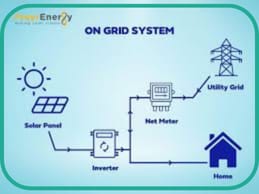
An on-grid solar system, also known as a grid-tied or grid-connected solar system, is a photovoltaic (PV) system that connects to the utility grid. Here are some key points about on-grid solar systems:
- Functionality: On-grid systems generate electricity from sunlight using solar panels. The generated electricity can be used to power appliances and equipment in your home or business.
- Connection to the Grid: These systems are connected to the local utility grid. This means they can draw electricity from the grid when solar production is insufficient (e.g., at night or during cloudy days) and can also send excess electricity back to the grid.
- Net Metering: Many regions offer net metering or similar policies for on-grid solar systems. This allows homeowners or businesses to receive credits for the electricity they export to the grid, which can offset their electricity bills.
- No Battery Backup: Unlike off-grid systems, on-grid systems typically do not include battery backup. This is because they rely on the grid for storage and backup power.
- Cost Savings and Environmental Benefits: On-grid systems can help reduce electricity bills and carbon footprints by generating clean, renewable energy.
- Regulations and Permits: Installing an on-grid solar system may require compliance with local regulations and obtaining permits. It’s essential to check with local authorities and utility companies before installation.
- Maintenance: Routine maintenance of solar panels and inverters is recommended to ensure optimal performance and longevity of the system
- Solar panels convert sunlight into electricity.
- The system is connected to the electrical grid through a net meter.
- Excess energy is fed back into the grid and offset against your energy consumption.
- The grid provides backup power when the sun isn’t shini
- Reduced electricity bills: Generate your own energy and reduce your reliance on the grid.
- Sell excess energy back to the grid: Get credits or cash for excess energy produced.
- Low maintenance: No batteries or complex systems to maintain.
- Increased property value: Installing an on-grid solar system can boost your property’s value.
- Environmental benefits: Reduce your carbon footprint and contribute to a sustainable future.
- How it works:
- Solar panels generate DC power.
- The inverter converts DC power to AC power, synchronizing with the grid frequency.
- The net meter measures energy production and consumption When the sun isn’t